#cockerel feeding
Text

Yknow, my partridge cockerel I've been growing up isn't as poorly typed as I thought. Though the only thing he may beat out my new blood cockerel is volume of feather along the leg. Still, I think I'll hold on to him for a while.
#chicken rant#no idea what I'll actually do with him but feed him#maybe I'll put the silver laced hens under him if I have time in my pen rotation?#yellow laced cockerels and red laced pullets#should theoretically help the laced variety type and possibly strengthen the pattern#hmm I rather like that idea#no steps closer to blue laced silver but def steps closer to better lacing#yknow in case the hatchery birds all turn out shit#which is highly likely#and the red laced hens would be a great leap forward for the blue laced red project!
1 note
·
View note
Text
News
My flock has contracted Marek's Disease.
Since 2019, after I brought home Lyra and Wren, my flock has been a closed flock. Meaning I take biosecurity very seriously, and opted to not bring any new chickens in or allow other poultry-keepers access to the yard where they are kept. The only birds that were added from 2019 until now have been from hatching eggs. There are a select few diseases that can pass from mother to egg, but not Marek's.
But within the past few weeks one chicken displayed symptoms of leg weakness and became unable to walk. I brought them indoors and started treating for vitamin deficiency, since that is by far the most common cause of sudden lameness in poultry. But she didn't get better, and then Lyra started walking unsteadily, and I knew something else was wrong. I suspected something was wrong with my feed and sent off a sample to get tested for mycotoxins, and switched feeds, because I know a lot of people have had issues with that lately. But then one morning I found Moss deceased in the coop, and it all kind of went downhill from there.
Sebrights are known for having extremely low resistance to disease. They are very inbred. It is the reason I lost Kip to fowl pox when everyone else recovered fine. And why all but one (her unnamed cockerel "emo" son) of the members of my flock who are descended from Lyra are affected. But none of the other tiny breeds I have, Seramas or Kikirkis, are known for being particularly disease resistant either. So. I am extremely cautious at jumping the gun and saying they wont be effected.
I sent off Moss's body for a necropsy on monday and got the results today, September 29th.

I do not know how this got into my flock. Our nextdoor neighbor got chickens a few months ago, but our birds don't have any direct contact. That is the only way I can think of.
There is a vaccine but it can only be administered to day old chicks. Vaccinating to prevent this was not an option.
It generally takes 4-10 weeks for the disease to develop after the chicken has been exposed, so it had to have been fairly recent. My flock has not been carrying this sub-clinically.
I genuinely don't know how this is going to go from here. There is no treatment for marek's disease. It is a virus. I have ordered a few herbal remedies with vague studies to back up some kind of efficacy helping reduce the damage the virus does and boost their immunity, but its mostly a crapshoot. The only good news I have with all this is that older birds are somewhat less likely to succumb to this disease. And the fact turkies and pigeons can't contract it.
The only birds displaying symptoms right now are Lyra, and Moss's unnamed pullet daughter.
Lyra is tentatively okay. I have crafted a sling for her, and she has been increasing in mobility over the last few days. She did not ever have full paralysis, so I am hopeful. Her daughter and Mouse, one of the younger keep-back pullets from this summers chicks, are the only casualties so far.
I'll be doing all that I can in terms of supportive care, but if any symptomatic birds get to the point I don't think they will recover from I will be euthanizing them. I will not be selling chickens anymore.
This disease has been a nightmare of mine for such a long time and now it is really happening. I am pretty crushed.
1K notes
·
View notes
Text
Was sun batheing with Beeper and it's so funny she wants to cuddle and be smooched so badly but her babies keep getting mad and it was like you could tell she was getting frustrated about it. What was also funny is little Mug was also getting grumpy because he has a more refined dignified personality compared to his older more rambunctious siblings. He just wanted to be stretched out in my hand but his siblings kept moving him. Donuts is also super friendly, he really takes after his mother Sugar and climbed up on my shoulder. Stapler though I'm keeping an eye on, he is pretty bitey and he has the most comb growth compared to his brothers.
It's always interesting to see how different the pullets act compared to cockerels in a brood. Cockerels are naturally more inclined to investigate new things so when I first stick my hand in the brooder they are the first ones to dash over. Pullets in a brood tend to be kind of coy with being pet, they will stand near your hand then duck under it to be petted then they pull away stand still then run away when you try to pet them but oh here they come back for more pets. It's very cute and endearing. Cockerels will just walk right into your hands demanding attention. The pullets also tend to take a lot of social cues from Beeper, like when to eat, drink, rest. The cockerels are rambunctious and will be busy jumping and play fighting around the brooder.
I think different broodies have different parenting styles as well. Princess Cream can be a bit curt with her chicks, if they struggle with food motivation she usually won't spend a lot of time tidbitting for them or showing them food. She is also very greedy and will hork up any treats before attempting to share the leftovers with her babies. Beeper on the other hand I sometimes have to seperate to feed treats to because she is insistent on making her babies eat everything I hand her. Due to this her chicks will actually eat a wider variety of food then she will? I hand her some greens and she goes "ew no, hey children? Children? Come eat this its good for you!" Beeper is actually a little bit underweight because of this as well, she is very insistent her babies get full crops before she eats. My other broody I let raise chicks before, Muffin, doesn't seem to understand chicks need food and water. She will call them over to food then get distracted eating it or she will go dust bathe while her chicks are peeping for warmth.
It's cool how good a mother Beeper has been so far. I definitely would let her hatch more eggs for me in the future if she wanted to.
#Beeper is like a gentle parent#though... when Beeper was very young i was very inistent she fill her crop before i left her alone#because she was so little and sickly#so maybe... she is copying that?#who knows what goes on in Beepo brain
60 notes
·
View notes
Text
So here's something interesting...
The Beatles Derek Taylor Never-Before-Heard Collection of Lost Beatles Recordings: Including the 1967 Kenwood Sessions and John Lennon Private Recordings
This is the track listing from the description:
Tape 1: Unheard Beatles Sgt Pepper Rehearsals from Kenwood late 66 early 67
Run time is 56 minutes, songs include:
Revolution #9, mainly John in many accents, George can be heard, Paul too, Ringo one time, Terry Doran is also heard being interviewed by John, Terry Doran was ‘The Man From The Motor Trade’ on Sgt Pepper, every identical animal sound effect from Good Morning Good Morning is featured throughout, probably pre-dates Pepper and John has the sound effects saved, cockerel, hens, sheep, horse, pigs, cat, dogs etc, the very ones used on Pepper. Sitar drones almost all the way through by George, Piano backdrop also
Track Listing:
That much Control
Monte Carlo rally sound effects Terry Doran is Jack Brabham Formula 1 racer
Cat Feeding Services (Monty Python esque sketch)
A million miles away, John Indian accent Beatles far east tours in 66
Crazy banjo song, JL bellows
I’m aware of the situation monologue
Swing your partners
Lennon.McCartney complaining about the heat
John and George shouting over a very loud backing track
John/Paul counting in 123 testing, JL turns it into a poem.
Dear Prudence very early demo John wrote it way before 1968
British Police are pigs, in an Indian accent
Tape 2: George Harrison With the Bonzo Dog Doo-Dah Band and Jimmy Page.
15 tracks, 59 minutes George with his Thames Valley muso friends, Jimmy Page, Jon Lord, Joe Brown, Sam Brown, Bonzo Dog Doo-Dah band (Neil Innes, Legs Larry Smith, Vivian Stanshall) Alvin Lee, all songs written by the Bonzos and George, all recorded at FP.
Track Listing:
George into talk while playing guitar, introducing a new song
Brazil take 1 written for the Handmade films project Brazil (never went to production)
Brazil take 2
Brazil Take 3
Sooty Goes to Hawaii
Mandalay monologue for handmade films production of the same name
Sooty Goes to Hawaii #2
Sooty Goes to Hawaii #3
Operatic Aria sung by Georges father-in-law and Olivia Harrisons dad Zeke Harrison, I doubt that Olivia has heard this
Bullshot theme song for Handmade films completed production.
Hare Krishna chant by everyone
Chant 2
While my Guitar Gently weeps with Jimmy Page on guitar
Same with Alvin Lee on guitar
if I Needed Someone
Tape 3: George with Bonzo Dog Doo-Dah Band band, all co-written 25.30 mins, 16 tracks
Track Listing:
Intro Legs Larry Smith
Do You Remember
Nothing Ever Changes
Urban Spaceman
Isle of Money (I Love Money)
Can you Groove (George)
There’s a Bright Golden Boil on my Penis
I Like Cesar
Misery Farm
Julie
Danda
When You Gotta Poop
Now You’re Asleep
Telling me The End
Viv Has Gone to Heaven
Mandalay Monologue #2
Tape 4: John Interviews Yoko 1969
Recorded by John in 1969, 45 minutes, John questions Yoko’s motives for being with him, discusses very personal matters, very revealing.
Tape 5: Yoko with Dr. Artur Janov
Yoko’s Primal Scream therapy 1 hr 40 mins, of very personal therapy, Yoko discusses John, music and very personal issues including John’s friendship with George.
Tape 6: “One From The Nursery” Unreleased John Ono Lennon Album
John and Kyoko Cox Tittenhurst Park
Run time is 47 minutes
4 tracks
Lots of John talking and playing acoustic guitar (sounds like his J60E) recorded at Christmas time, Various songs stand out, all written by John & Kyoko
John, I Love You
I Wish You Were my Father.
#john lennon#paul mccartney#george harrison#ringo starr#the beatles#derek taylor#yoko ono#a lot to unpack here
79 notes
·
View notes
Text
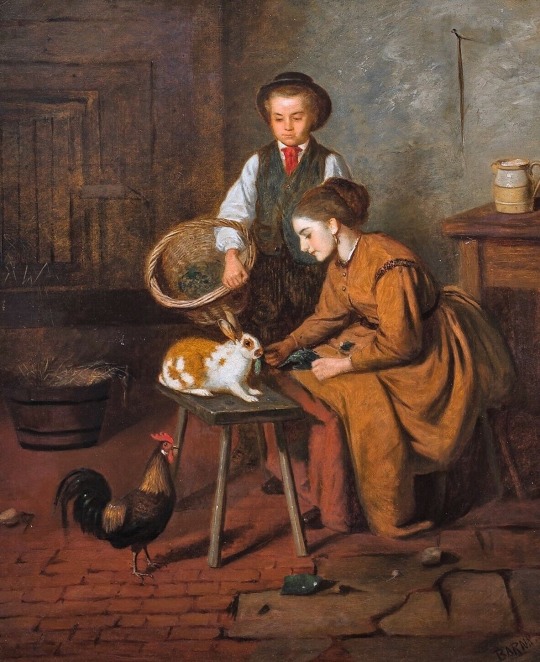
Excellent huge 19th-century oil on canvas painting by Barns depicts a mother and son feeding a rabbit with the help of a cockerel. Inside of the cottage is exquisitely painted, and the faces and animals are incredibly detailed. presented in original condition with a gilded frame.
NY Elizabeth
10 notes
·
View notes
Note
hey hope youre okay, I hope this may make you smile :)
we got two new chickens today! brings it up to 1 cockerel and 7 hens (3 of which we raised from chicks), they're settling in a little, a bit shy and scared of our very chicken-friendly dog. but very cute and sweet.
I first got chickens when I was 8 and i have so many fond memories of growing up with them, playing, cuddling and feeding them. some of my fav memories were outside with them.
my fav thing was feeding them leftover spaghetti and watching them slurp it up - if you haven't i'd recommend it - 8-year-old me found it hilarious
your chickens look lovely and very well cared for, and I wish you all the best. you are always so kind and it is very inspiring to see in a sometimes mean environment
oh that's so awesome!!
what kind are they? one day i'll be able to have another cockerel and i'll be so happy, honestly. and i think i remember you telling me about the spaghetti! i need to get them some 'cause i think they'd love it. <3
but thank <3 <3 i do my best to take care of them, they mean the world to me. i've always wanted to have chickens and grow vegetables and help feed the people around me. life goal, y'know? and i'm so thankful that i've finally gotten to do that.
8 notes
·
View notes
Photo

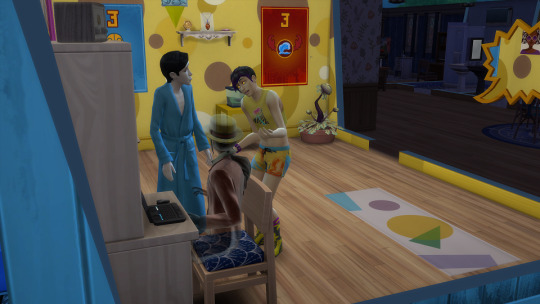
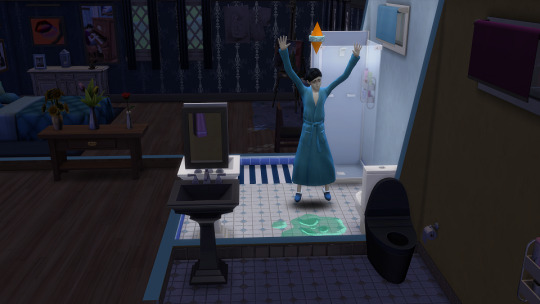


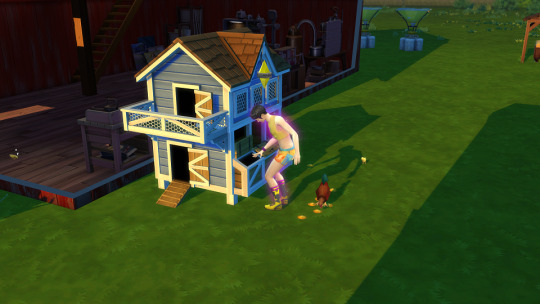


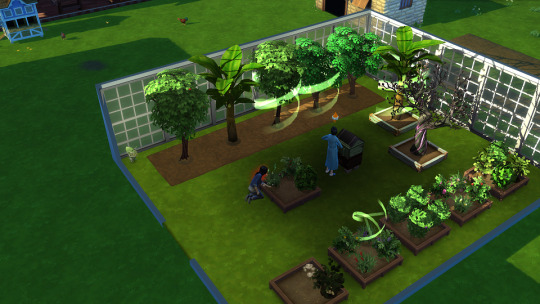

We have reached the midpoint of Summer in the Chill Save (aka Wednesday) and you know what that means -- it’s time for SimCity Founding! And my Sims had a very busy one (50 pictures worth!), so let’s dive right in, shall we? Starting with the morning shenanigans:
-->Picked up with Smiler chatting with Guidry about their newly-acquired Fear of Death and how to relax -- when Victor ran in terrified because he heard a creepy voice. XD Oh, Paranormal Stuff, you sure know how to pick your moments. XD Fortunately Victor was calmed being around his themfriend, and Guidry was able to successfully remove Smiler’s Fear of Death with a pep talk, yay! The same could not be said of Victor’s fear of his own house -- after I had to cancel him trying a Scruberoo on the slime creature in one of the upstairs bathrooms (because Smiler and Guidry suddenly wanting to “see overcharged Sim” made me realize, right, he was probably in the danger zone for overcharging), he subsequently became too freaked out to use that bathroom. I had to have him use the other and then hide under the covers for a while before he could get back to sleep.
-->Alice, meanwhile, woke up from her outdoors nap to “bathe like a beast” in the tub -- as you can see, she was really starting to feel the werewolf Fury. Concerned but aware I could manage her should she transform, I had her distract herself by making a nice strawberry cake, then packing up two pieces of it in a picnic basket for her and Victor later. :)
-->Smiler, now unafraid of getting zapped, managed to finish their latest computer chip as the cockerel crowed, then spread some feed for the chickens and cleaned out the coop! Which led to them attempting to clean out the roach-infested trash can and not succeeding very well. Ugh. Damn “Reduce & Recycle” lot challenge!
-->And Victor, finally having gotten adequate rest, got up and started tending to their greenhouse, evolving a whole bunch of plants and giving the bees some mite treatment while Alice did some weeding and entertained a stray chicken and Smiler chatted with the plasma fruit tree (which I have now moved slightly forward in the hopes that the damn thing will actually FRUIT again).
Busy morning, no? And it wasn’t even my intention for them to stay on the farm! Nope, once everybody was all set, Alice got on her phone. . .
#sims 4#the lazy save#victor van dort#alice liddell#smiler always#the smiler#valicer#fun fact: I ended up having to split playing this update between two days#because of bad timing on Saturday meaning I only got through this morning bit#now that I see how long this update IS perhaps that was a good thing#I wouldn't have gotten a chance to do anything ELSE on Saturday if I'd played the whole thing that day#but yes just your typical morning on the Valicer Haunted Farm really XD#I'm glad Smiler was able to clear their fear of death though#and finish their computer chip without being zapped#now if only they had a regular source of plasma fruit again. . .#queued
3 notes
·
View notes
Text
April blog #2
Butterfly museums
There are many ways for you to discover and observe the beauty of the butterfly species. There are many exhibits and museums that have been created over time to allow people to enjoy the natural scenery. These museums besides providing for the people it allows butterflies to have a safe environment to lay eggs,pollinate, allow caterpillars to grow,eat and retreat into chrysalises.
The very first butterfly museum was created on March 29, 1986 in Penang, Malaysia. It was the world's first tropical live butterfly haven. This butterfly museum was created by David Goh who was a young teacher who had the interest and passion for butterflies. Because of his passion he was inspired to create a tourist destination in Penang. This museum has been around for about 37 years that has dedicated it's time to educate people on the butterfly cycle and much more.
Over time there have been many more butterfly houses that have been created allowing there to be many more destinations for people to visit in the discovery of the butterfly history.
Here are some of the top 10 butterfly museums in the United States
1.Butterfly World, Coconut Creek, Florida
One of the very first butterfly houses to open in the US. It has three acres of butterfly aviaries to explore. Has a butterfly farm,garden, bug zoo etc.
2.Magic Wings Butterfly Home, Durham, North Carolina
Home to over 50 different species of butterflies,tropical plants,birds, etc.There is a time when dozens of butterflies are released into the rain forest landscape.
3.Purdy Butterfly House, Huntsville, Alabama
It is a rain forest landscape home to thousands of native butterflies and other critters like turtles,frogs, etc.It promises an amazing experience that all family members can enjoy.
4.National Butterfly Center, Mission, Texas
It aims to teach visitors about biodiversity and the role butterflies play in the ecosystem. It has over 200 butterfly species to admire.
5.Bear Mountain Butterfly Sanctuary, Jim Thorpe, Pennsylvania
Everyone of all ages can enjoy this sanctuary. Visitors are allowed to hand feed butterflies and stroke the exotic frogs. There are many other programs that educate and entertain all kids and adults.
6. Butterfly Pavilion and Insect Center, Westminster, Colorado
Home to over 16000 rainbow colored butterflies. There are also different critters to discover such as tadpoles, exotic birds and frogs.
7.Key West Butterfly and Nature Conservatory, Key West, Florida
Home to over 60 species of wile and free flying butterflies. The conservatory is a resemble to a tropical garden which includes gazebos,waterfall, trees,etc.
8.Monarch Butterfly Sanctuary, Pacific Grove, California
Over 25000 monarch butterflies travel through the sanctuary in the months of October and February every year as part of their mass migration.
9.Cecil B Day Butterfly Center, Pine Mountain, Georgia
Has more than 1000 free flying butterflies and tropical birds flying around the tropical flowers and waterfalls.
10. Cockerell Butterfly Center, Houston, Texas
It is home to hundreds of species of colorful butterflies. Besides the butterflies there are dozens of more exhibits to explore such as a crawl through beehive and much more.
You should go out and visit a butterfly museum today before it's too late. Each year the butterfly species population decreases by two percent. Enjoy the butterflies while you can, Go out and explore the exotic blooms, rainbow forests and rainbow colored butterflies.

0 notes
Text
The Vicar Man by Amelia Crowley
The Vicar Man by Amelia Crowley. Hugely enjoyable.
Dora is a barmaid.Usually her life is fairly simple: she gets up, cleans the inn, feeds the chickens, argues with the increasingly obstreperous cockerel, listens to the woes of her fellow barmaid, avoids doing the laundry, and serves drinks to the motley crew of islanders who lurk about the taproom every night.The same old routine, day in, day out.
Tonight, though, is different.
Tonight, just…

View On WordPress
0 notes
Text
Rhapsodising About My Ideal Life
I dream of a life on a farmstead, where we produce our own food. Potatoes are grown in tyres and barrels, chickens feed on potato peelings and on the insects in the cherry tree grove, carrots and onions grow together to ward off each other's respective pests and corn grows around sweetcorn, with squash growing at the base. A few sheep graze in our largest field.
The house we live in is made of tightly-bound straw bales, built on a foundation of stone and wooden floorboards, with wooden frames and cladding and a coat of limewash. A waterwheel provides for the little electricity we use to light the house and the computer we turn on occasionally to find out facts I don't know or for my wife to operate her website that brings in money we need. A shed sits outside with our tools, as does a compost toilet. We cook with a woodburning stove, and the straw bales are excellent insulators.
Potatoes - baked or roast or boiled- sit at the centre of every meal, along with eggs - fried or boiled or poached - and a pot of stewed vegetables. When one of the chickens gets old, we slaughter it and eat the meat for our next meal.
Inside, I live with my wife and our three children. Twelve years ago now, I promised here my love, protection, provision and, with her input, leadership, and so far I'm holding good to that promise. We had our eldest child when we entered this life, and that child is turning ten in a few weeks. We have no television or smartphones and rarely make use of the computer; we communicate with letters and entertain ourselves with the natural world and the many books me and my wife brought with us to the house I built for us.
On the weeks when we can make it, we mount the bus and head off to our local church to praise God and study the Bible together and maintain our friendships. And as a support network, where we trade meals and show the kids there farmer's things. If some tool or gadget needs repairing and I don't know how, there'll be someone at church who knows and is happy to help.
Before beginning this life, we purchased many clothes in all ages for our children. For winter hats, scarves, and gloves, we have the sheep. I shear them and wash and card the wool, while my wife knits it. Most of our wool goes towards handicrafts (plus ones I made out of wood) that we sell by the internet, bringing in the little money that we need for this lifestyle - bus fares, postage stamps, vet's fees and occasionally replacing tools and renting cockerels and rams. We're blessed to live here in the UK, with free healthcare. Because we use so little money, we pay no taxes.
We have no smartphones or news, and we're quite happy for it. No online sniping or news about catastrophes we're powerless to stop to depress us. Our children are homeschooled by whoever has more time that day, learning about the natural world, mathematics, history, science, art and (importantly to me) logic. As they get older, they're increasingly helping out on the farm.
I know it's unlikely I'll ever get to live like this, but I sure hope I do some day.
1 note
·
View note
Text
Golden comet chicken

#GOLDEN COMET CHICKEN FREE#
Hens feathering color varies with brown, black, redish and white feathers. This strain will start to lay eggs at a younger age than most standard breeds and produce large to extra large brown eggs.Īs chicks the cockerels are white and the pullets are more brownish red in color. Golden Comets are docile birds and extremely easy to work with. And when it comes time to put some meat on the table, a larger chicken would be your best option here.Īlthough the emphasis of this article is on egg-laying chicken breeds, which is the greatest priority here, other characteristics, like foraging or brooding, may also be of special interest.Beautiful friendly Golden Comet Pullets for sale, these are a sex-link hybrid chicken and should have a productive egg laying career. They are birds that are broody, birds that forage well, types that are excellent layers, and from a pure sustenance standpoint, birds that are big enough to make them worth-while eating.Ĭonsider that birds which brood well will keep your flock healthy and populated.Ĭhickens that are excellent foragers make the best free-range types, and those that are hardy egg layers will always keep you in eggs. And if that’s all you want to do, there is certainly no problem with that.īut, there are other characteristics that may also come into play, and they at least deserve to be mentioned in the same breath. Raising chickens just for eggs is a very practical way to have your yolk and eat them too. Chicken Breeds That Lay Blue, Green, Pink, White, and Other Egg Colors.Here are some other articles you might want to read about raising chickens: It is thought, by many, that the best chickens and the tastiest eggs are produced by free-range birds, and as long as they have a shelter for the night, you can have free-ranging chickens that will survive and flourish. This works best on farms that have several acres of land on which the chickens can roam. You’ll need a little more space than a city backyard, but a suburban yard or a small farm would work well.įree-range can be a very large penned-in area, perhaps an acre or more, or as the name implies, free-range anywhere around your property. Movable pens allow constant foraging in different areas and fresh greens. You can make either a permanent pen, with a small indoor shelter in which to roost or lay eggs or have a movable pen that can be picked up and moved from place to place. Pens are a great way to keep your chickens outdoors yet give them ample space to move around. If properly insulated, this can be a year-round chicken house. There should be a little bit of a yard area outside where the chickens can stretch their legs, and this may be a good area for feeding and watering. In virtually any backyard, unless perhaps in the heart of the city, a chicken coup can be erected where the chickens can be housed. Egg productions (annual)Īlthough the listed chickens here are some of the most popular and best egg layers of them all, you’ll have to determine which kind suits your own personal needs.Ĭonsider the available land space, how much you want to care for them, a little or a lot, their overall disposition and what you are going to do with all of those eggs! 1. However, in contrast to their size, Sussex chickens don’t need big spaces.īe careful when raising Sussex with other breeds. One of the heaviest layers, not only because they lay more than 250 eggs per year but also because the females weight almost 8lbs on average. They tend to bully others and sometimes eat their eggs. One thing, though, Australorp is not the easiest to raise with other breeds. If you’re a total beginner, Australorp might be the best choice for you. Egg productions (annual)Īustralorp chickens are one of the human-friendliest chicken breeds, they lay a fairly high amount of eggs, they have quite a lot of meat, and their color is just gorgeous.
#GOLDEN COMET CHICKEN FREE#
However, their coats are fluffy and retain moisture, so they will always need a place of shelter, and they don’t fly very well, so if they are free ranged, predators might become an issue. They are best in a confined setting, like a penned-in area or a coup, but under the right circumstances, they also make good free-range birds. Granted, this is an egg-laying chicken breed that is only capable of about 150 eggs per year, but if you have kids, or if you are actively interested in a chicken more for its docile nature, this is a wonderful choice. What’s not to like about a Buff Orpington? These are big and beautiful birds that actually make great pets.

0 notes
Text
GROWTH, HAEMATOLOGY, SEROLOGY AND CARCASS CHARACTERISTICS OF GROWING COCKERELS FED MAIZE, SORGHUM, MILLET AND THEIR COMBINATIONS IN THE SEMI-ARID ZONE OF NIGERIA | Journal of Global Agriculture and Ecology
In a semi-arid environment in Borno State, Nigeria, the response of growing cockerels was evaluated when given maize, sorghum, millet, and their mixtures as the main energy source. In a complete randomised design, 270 (270) seven (7) week old growing cockerels were assigned to six dietary treatments in groups of 45 birds per treatment replicated three times with fifteen (15) birds per replicate (CRD). The main energy sources in the treatment diets are 100% maize (T1), 100% sorghum (T2), 100% millet (T3), 50 percent maize and 50 percent sorghum (T4), 50 percent maize and 50 percent millet (T5), and 50 percent sorghum and 50 percent millet (T6). The study took ten (10) weeks to complete. All of the treatment groups had no significant changes in daily weight increase, feed intake, or feed conversion ratio (FCR). Final live weight and overall weight gain were superior (P0.05) in birds given 100 percent maize, 50 percent maize and 50 percent sorghum, 50 percent maize and 50 percent millet, and 50 percent sorghum and 50 percent millet. Except for lymphocytes, there were significant (P0.05) variations between treatment groups for all haematological measures, however the haematological values obtained were all within normal ranges for growing cockerels. Total blood protein, albumin, globulin, and alkaline phosphate were not significantly different (P>0.05) in serology. However, urea, creatinine, cholesterol, alkaline amino transferase (ALAT), aspertate amino-transferase (ASAT), total bilirubin, and conjugate bilirubin all differed substantially (P0.05) but did not follow any particular trend among the treatment groups. Dressing percentage and yield of breast, drumsticks, wings, neck, legs, and head had no treatment impacts. The findings of this study demonstrated that sorghum or millet, or their mixtures with maize, can be utilised in the diets of growing cockerels in Nigeria's semi-arid region without affecting performance.
Please see the link :- https://www.ikprress.org/index.php/JOGAE/article/view/490
0 notes
Text
youtube
Things I like
-Most birds are active and in good spirits
-no beak mutilation
-bedding in the indoor area looks clean and cozy and good for dust batheing
-plenty of natural safe enrichment. You don't want very tall perches for battery hens they could break a bone.
-Communal roosting
-cockerels used for meat rather than culled at a day old
-use of solar for energy
-when the birdflu isn't a threat they have outdoor pastures the birds can access anytime during foraging time.
-natural daylight
Things I don't like
-birds seem dirty due to communal roosting situation, they are getting pooped on basically. Changing the layout to a almost look like stairs would probably help.
-some birds still show evidence of feather picking, obviously not as bad as American battery farms but always room for improvement. They didn't have as much evidence of this when they could go outside but unfortunately they can't right now for their own safety.
-their feed regime might contribute to the feather picking behavior and poor feather quality if they are truly only using byproducts in their feed. Wheat,soy, and corn byproducts are harder on a chickens gut microbiome than better ingredients.
Things to note-
-Leghorns are more prone to neurotic behaviors than other breeds (this can happen when you take a flighty land race and turn it into a production animal) if they had a different production breed they might see less feather picking. I think they chose pure production leghorns on purpose for sustainability reasons so can't fault them for that.
Their feathers will likely always look a bit shit. White feathers are structurally weaker than pigmented ones and that goes pretty much for all birds.
The feathers you see on the ground are just molted not from plucking of anything like that.
What do you think fellow chicken keepers?
39 notes
·
View notes
Video
youtube
cockerel feeding
0 notes
Text
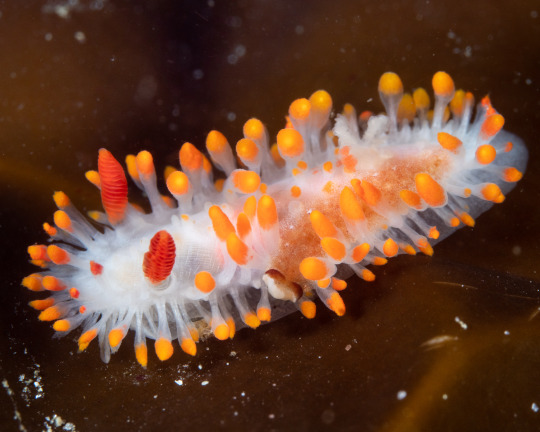
All aboard the slug bus! This little kelp crawler is a Cockerell’s dorid nudibranch sea slug—and tucked away in the slug’s bulby branches is a red commensal scale worm along for the ride!
Cockerell’s dorids (Limacia cockerelli) feed on carpets of small animals known as bryozoans—their orange color derives from pigments in their food. Red commensal scale worms (Arctonoe pulchra) are avid hitchhikers that use sea stars, snails and slugs as convenient craft services to their next feeding ground.
The worms don’t bother the slugs, save for occasional pokes of the slugs’s gills that send the nudibranch into ticklish winces. The slug here is about an inch / three cm long, and the buddy pair was spotted just off the back deck of the Aquarium!
#monterey bay aquarium#send nudibranchs#hey is it cool if i hitch a ride?#oh for shore it's commensal good little buddy little pal#neat thanks i'll be your little slug bug!
713 notes
·
View notes
Text
My first chicken surgery!
I got to do my first ever bird surgery while on placements this past summer during my final year of vet med school :)
Lucky is an 8-week-old (at the time) Red Sex-link cockerel with a 5-week history of crop stasis, also known informally as “sour crop”. On physical examination, he did indeed have a distended crop with a doughy consistency (even after he'd been fasted for almost 18 hours before his appointment), and when I palpated his keel I found he had a body condition score of 1.5 out of 5 with quite a bit of muscle wasting, meaning that he was fairly emaciated. His owners also noted that although the distension did not cause him any apparent discomfort, he was smaller and had been growing at a noticeably slower rate compared to his brothers and even his sisters.
First off, what is crop stasis/sour crop? In birds, crop stasis is a common indicator of disease characterized by impaired motility and delayed emptying of the crop. There are several conditions that can lead to its development, including physical obstruction or impaction of the crop, which is typically caused by the ingestion of tough, fibrous vegetation or other foreign material that birb definitely should not have eaten, but did anyway. Decreased crop motility can additionally be the result of high environmental temperatures, prolonged time between feedings, heavy metal toxicosis, Marek’s disease, and many other things.
In order for me to figure out which of these things was going on with Lucky, I offered to perform a biopsy of his crop, which involves surgically cutting out a 1cm x 1cm square of the actual crop. And I figured, while I'm in there anyway, why not do something called an ingluviotomy? "Ingluvi-" referring to the crop, and "-otomy" meaning to cut into an organ or body cavity, usually with the intention of getting a good visual of its interior - and in the case of suspected impaction/foreign body obstruction, looking for said foreign body and safely removing it. (I was going to make a passionate plug in this post about how it saddens and terrifies me that people will attempt to do this "surgery" on their own at home without pain control or maintaining any sort of sterility but this post is long enough and that is a horrifying can of worms that I won't go into today.) Luckily for Lucky (heh), his owners were able to give me the ok to go ahead with this procedure, so I took him back to the hospital, sedated and anesthetized him, blocked the nerves around the area I'd be cutting into, took a biopsy sample, and did the ingluviotomy. This is what I took out of his crop.

Long blades of grass and/or pine needles, bits of sand/gravel, and a whole wasp-looking insect (black thing in the top/middle left). Once I finished digging all of that out, I gave Lucky's crop one last flush with some saline, gave him a dose of antibiotics and anti-inflammatory medication, and closed up his crop. Here he is waking up from his surgery, still feeling a little high and wrapped up in a towel with some heat pads:

I put the crop biopsy sample in some formalin and sent it off to my school's animal pathology lab, in along with a fecal sample and a swab I'd quickly taken of inside of his crop. The final report I got back a week later wasn't too exciting - no evidence of parasites and/or their eggs in the swab or poop sample, and microscopic evaluation of the biopsy just showed signs that the bird hadn't eaten in a while (which we already knew) and some inflammation, which also wasn't surprising. But here's the histology photo anyway, because it's pretty.
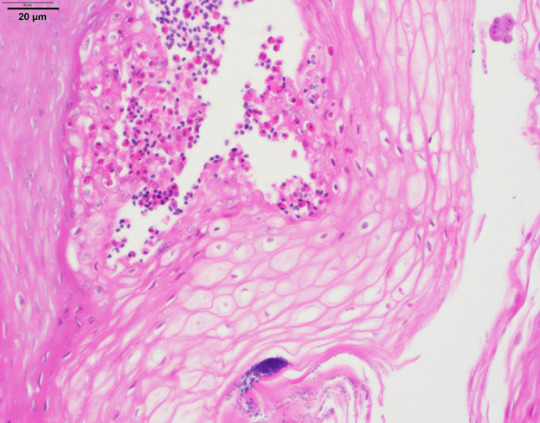
After returning home, Lucky was eating liquid food and taking his oral medications like a champ. The plot thickened though when his crop just filled right back up by the end of the first week following his surgery. So, I asked his owners to bring him back in for another exam. This time, his crop seemed to contain sludgy, liquid content only, but his body condition score was a 2.5 out of 5 and he'd put on a bit of muscle weight. I wasn't happy that his crop was still distended though and wanted to try to get to the bottom of it, so I sedated him again and took my first chicken x-ray:
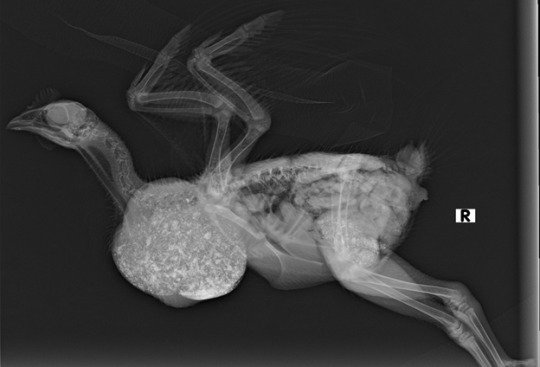
Aside from the tennis-ball sized crop which seems to be filled with partially digested feed pellets and some grit, this is pretty much a normal x-ray. I was specifically looking for enlargement of the proventriculus or any other section of the GI tract that would indicate that there was a blockage somewhere along the line, but there's no evidence of that here. So, I sent Lucky back home with a prokinetic medication, and recommended that he start wearing a crop-supporting birdy bra (https://crazy-k-farm.myshopify.com/products/birdy-bra-crop-supporter-chest-protector).
It's been 2 months and Lucky's crop is still enlarged, but he looks great otherwise. He's gotten taller and started growing in his big boy feathers, and eats and drinks and behaves just like the other chickens in his flock. So why is his crop still like that? We really don't know. Secondary to crop stasis, the crop can become pendulous, i.e., enlarged and filled with an excessive amount of fluid. The exact cause of pendulous crops hasn't really been scientifically studied, despite their being a pretty common presenting complaint by owners of backyard poultry flocks. A few old studies suggest that there is a genetic component that results in poor muscle tone of the crop. I've also heard avian vets say that even after you fix the underlying cause of crop stasis in a bird, it can still end up with pendulous crop afterward if it was distended for a long enough period of time that the physical stretching and pressure on the crop wall damaged the nerves and muscles within. It's also possible that I might have accidentally traumatized one of these nerves during the biopsy and surgery, to be completely honest. Or, there could be some sort of unknown disease going on with Lucky's muscular system - certain muscular dystrophies in dogs and cats can result in impaired function of the esophagus (which the crop is a part of, in birds).
Whatever the cause, crop bras seem to be pretty popular among backyard flock owners who have the odd chicken or two with pendulous crops. Anecdotally, these birds seem to be more prone to re-developing crop stasis, but can apparently maintain a good quality of life with regular monitoring of appetite and body weight. It's been so far, so good for Lucky, at least!
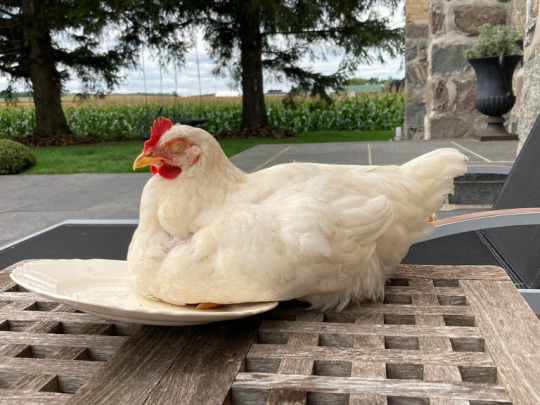
(All photos belong to Lucky's owners and myself, please do not repost without permission)
References:
1. Worrell AB. Current trends in avian pediatrics. J Exot Pet Med 2012;21:115-123.
2. Morrisey JK. Gastrointestinal diseases in psittacine birds. Semin Avian Exot Pet 1999;8:66-74.
3. Greenacre CB, Morishita TY. Backyard poultry medicine and surgery: a guide for veterinary practitioners. Chichester, West Sussex, UK: John Wiley and Sons, 2021:292-293.
4. Ramesh R, Vijayanand V, Gopalakrishnand A, Ayyappan S. Crop impaction and its surgical management in a domestic fowl. J Entomol Zool Stud 2020;8:259-260.
5. Rigdon RH. Pendulous crop in the chicken: a pathologic study. Am J Vet Res 1961;22:379-381.
6. Rigdon RH, Ferguson TM, Couch JR. Spontaneous-occurring muscular necrosis in the chicken. Poultry Sci 1962;41:398-409.
7. Almeida EA, Silva FHA, Crowe TG, Macari M, Furlan RL. Influence of rearing temperature and feed format in the development of the pendulous crop in broilers. Poultry Sci 2018;97:3556-3563.
8. Brinkley C, Kingsley JS, Mench J. A method for guarding animal welfare and public health: Tracking the rise of backyard poultry ordinances. J Commun Health 2018;43:639-646.
9. Gosbell M, Fowler A. Gastrointestinal obstruction: a review, its diagnosis and treatment. Twentieth Association of Avian Veterinarians Australasian Committee Annual Conference Proceedings 2012:129-136.
10. McAtee BB, Heseltine JC, Guo LT, Willard MD, Shelton GD. Dysphagia and esophageal dysfunction due to dystrophin deficient muscular deficiency in a male Spanish water spaniel. Vet Quart 2018;38:28-32.
11. Gaschen F, Jaggy A, Jones B. Congenital diseases of feline muscle and neuromuscular junction. J Feline Med Surg 2004;6:355-366.
#veterinary medicine#veterinarian#backyard chickens#science#pet bird#pet chickens#original post#long post#biology#anatomy#pathology#rooster
170 notes
·
View notes